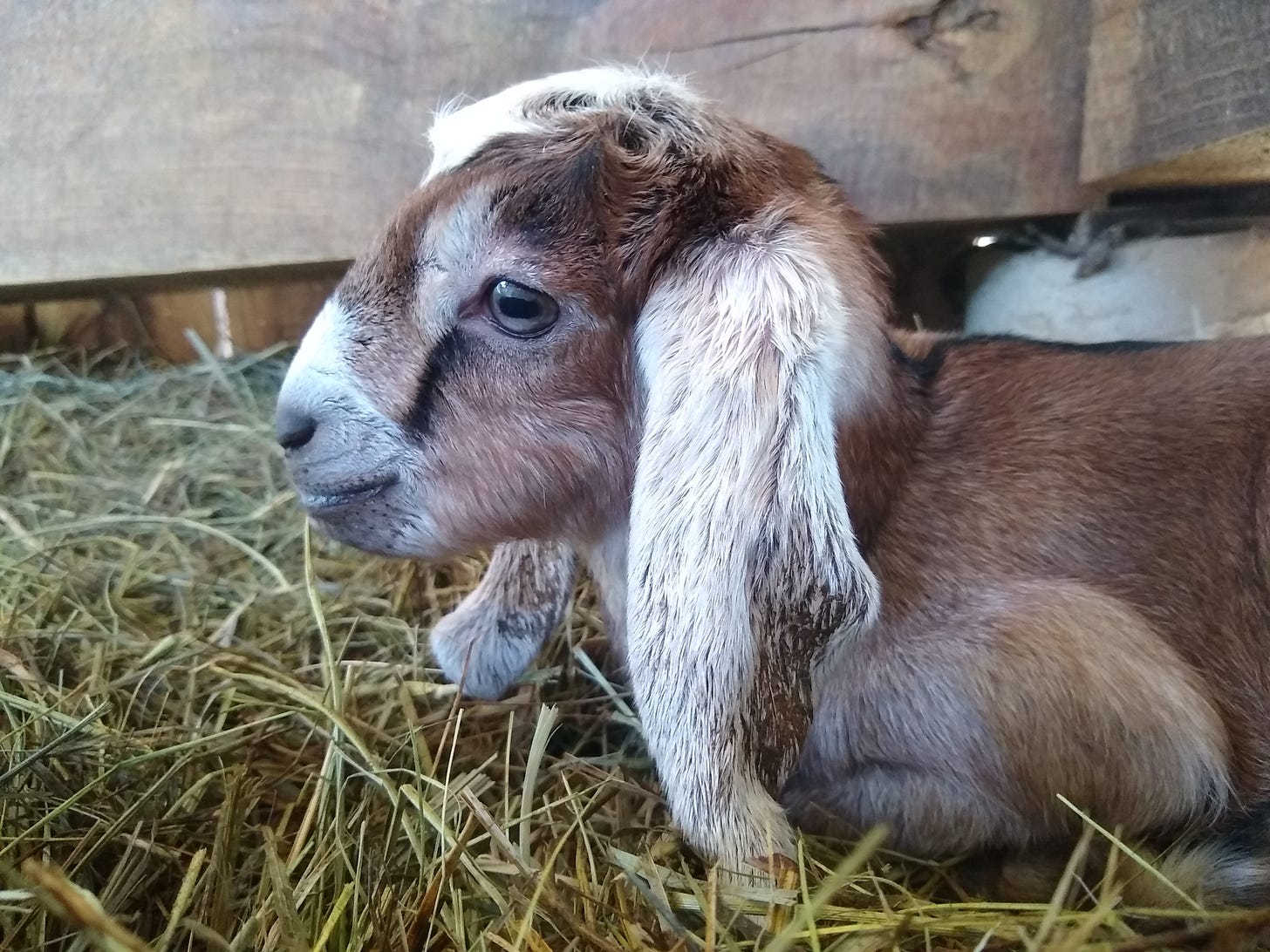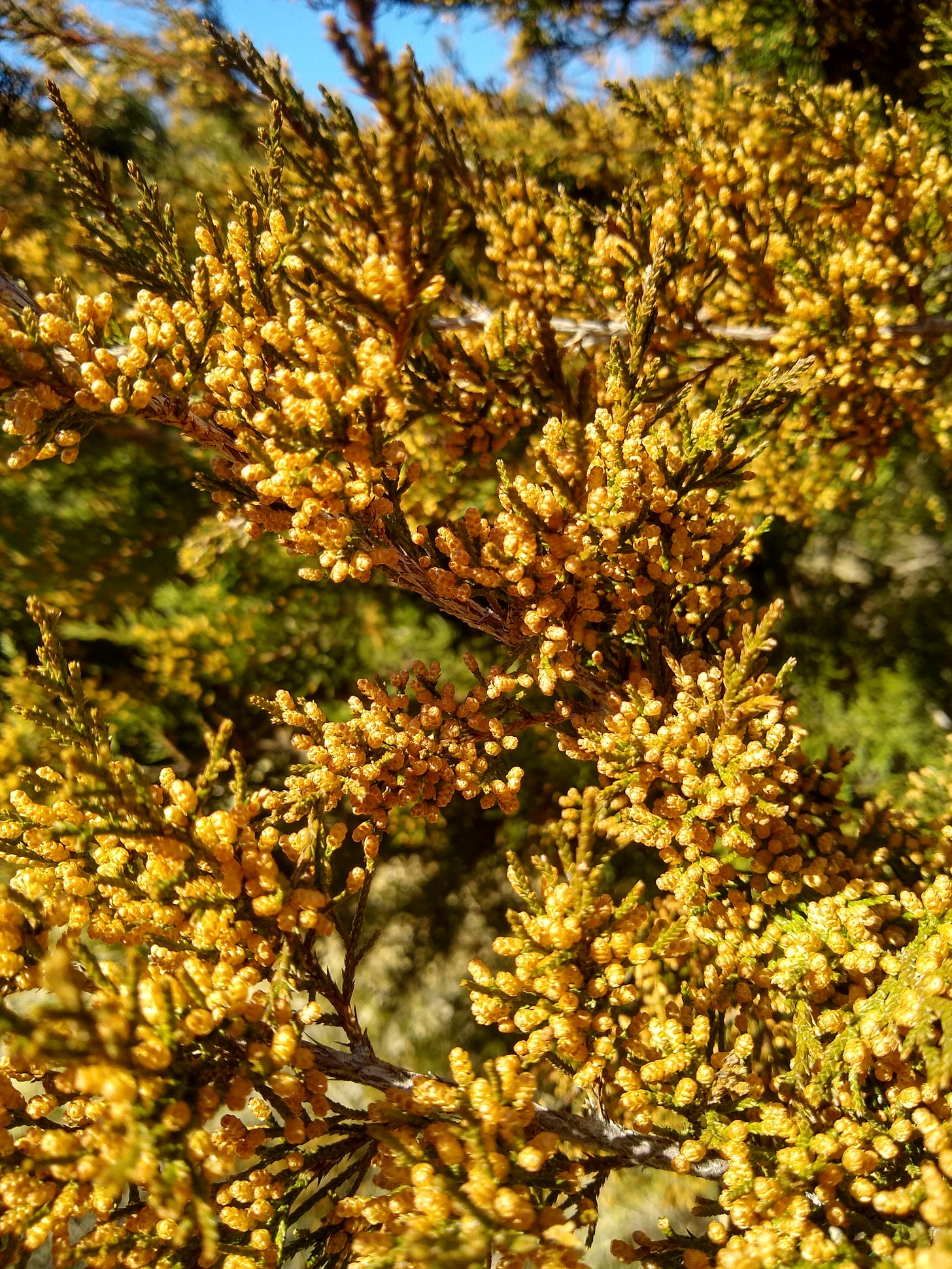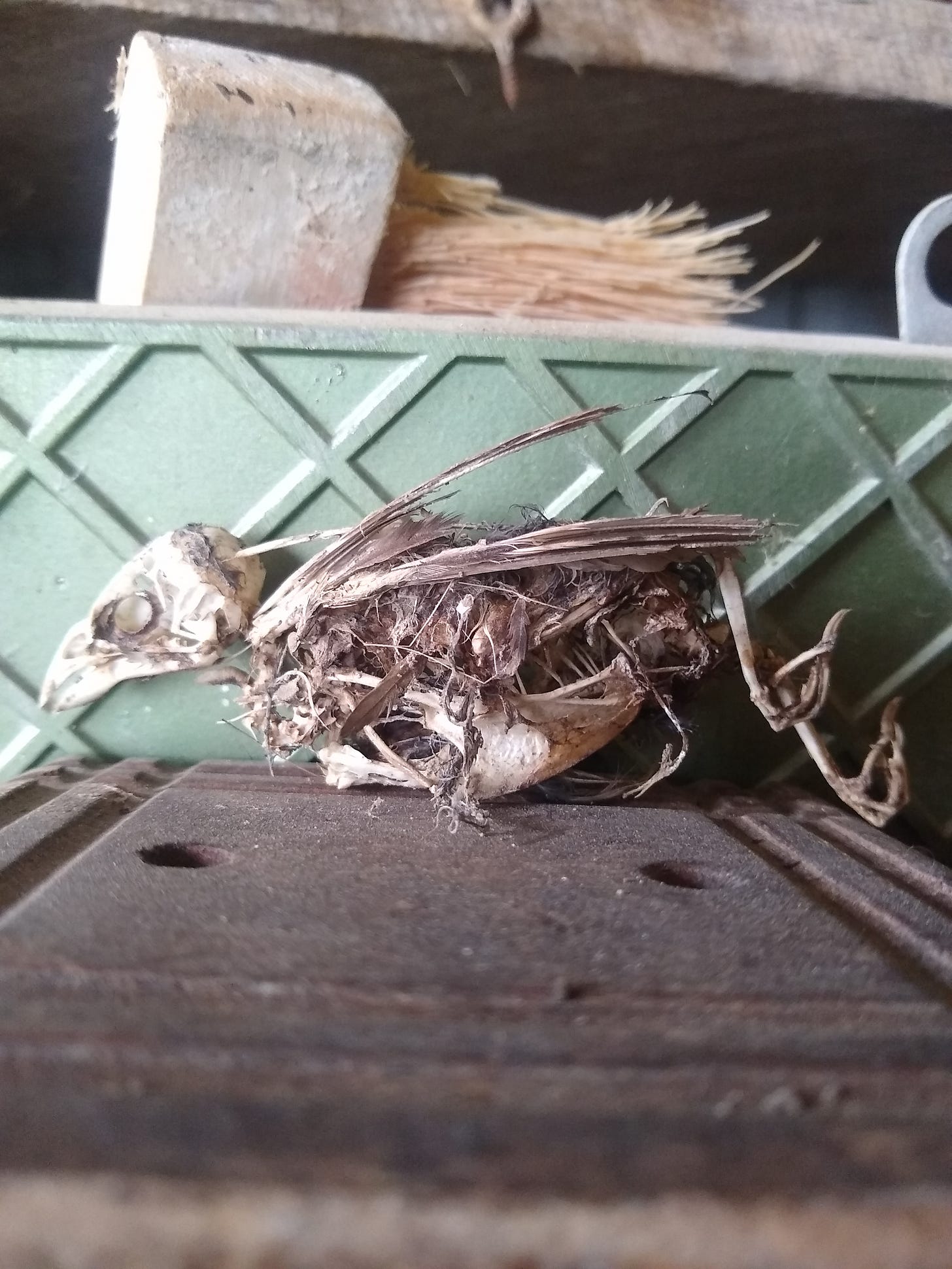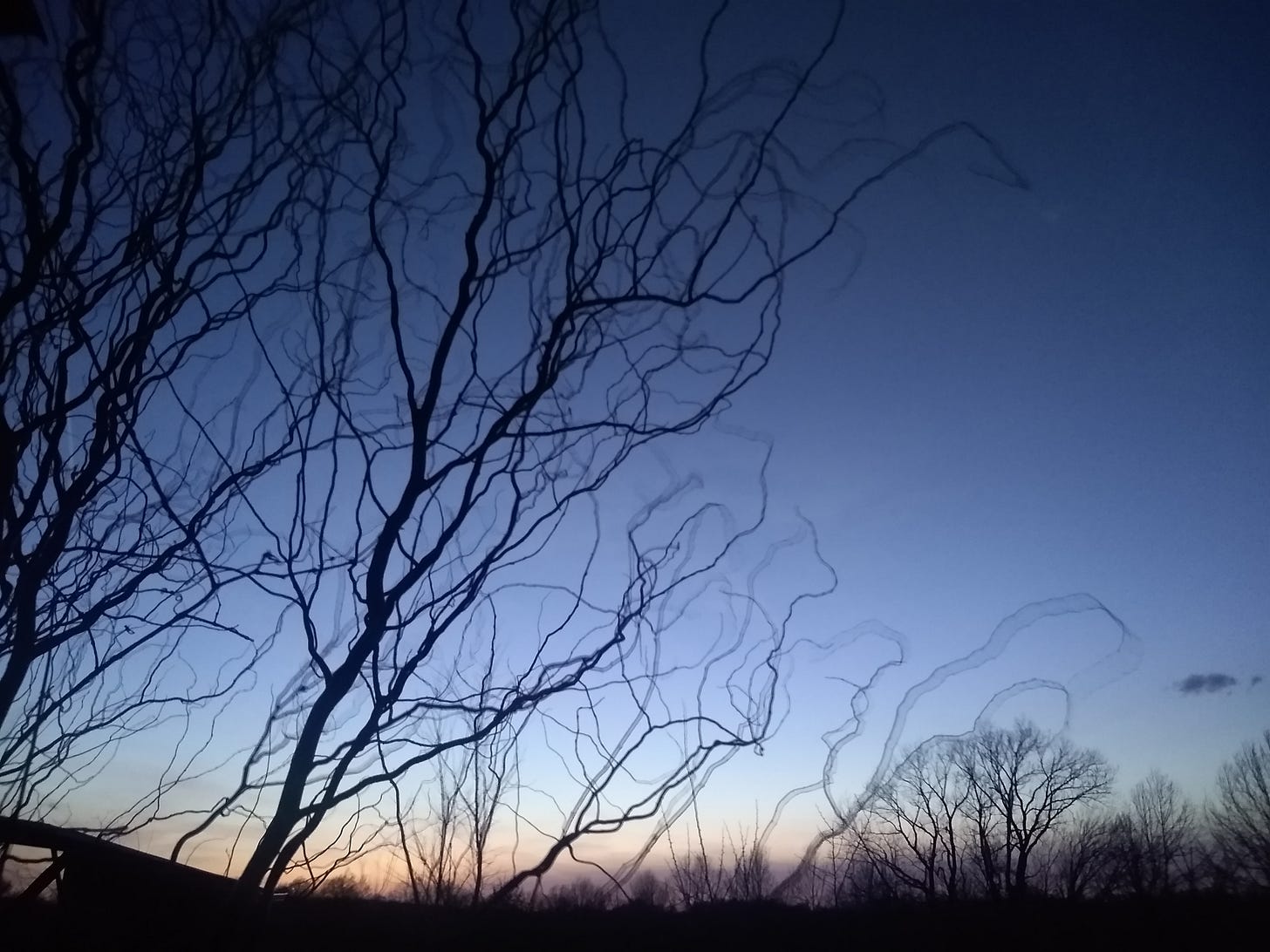Little Plastic Flags
Even sustainable agriculture is rooted in control, but the nature of regeneration is unmappable in human time.
Eastern red cedar has been spicing the air with drifting clouds of gold pollen out and along the ridge tops and rolling depressions that have long stood untouched by prairie fire. Early birds, robins and doves, flit through this gilded haze, roiling the puffs and plumes into allergenic contrails and cyclones, like the vengeful, ghostly smoke of blazes not yet lit. The panhandle of Texas is burning, and part of the million-acre fire’s fast spread into Oklahoma is on account of large colonies of cedar, alongside excessive heat during plant dormancy. Until last night’s recent entry of cool, humid air– seasoned with a minor amount of pea-sized hail– Northeast Missouri has been under a red flag warning, so seeing the specter of smoky yellow pollen out of the corner of my eye, drifting and blowing on the wind had me a bit spooked, until I realized that it was not the brimstone of wildfire, but a cloud of microscopic genomic information.
Pollen is not technically a male gamete, that is to say, pollen isn’t tree sperm, but instead a gametophyte, an essentially separate organism, which will go on to produce gametes once it has found its way to the complimentary reproductive infrastructure– the cone in the case of gymnosperms like Eastern red cedar, or commonly the pistil in angiosperms. Each grain of pollen starts off with a vegetative and a generative cell– upon deposition of the grain, the vegetative cell develops into a “pollen tube”, nutrients are exchanged to the generative cells which develop into male gametes, and the female is pollinated. There is no reason to blush in the midst of tree sex, it’s all very cool and transactional.
Pollen can be described as either anemophilous (wind-loving) or entomophilous (insect loving). Cedar pollen is clearly anemophilous, and as such the outer casing of the pollen is embedded with air sacs to help it remain buoyant on the wind. While I have not specifically seen it stated anywhere that insects aid in Eastern red cedar pollination, I have observed hungry honeybees dancing on their golden brown cones in March. Subtler but nonetheless effective, other examples of anemophilous pollen abound this time of year: namely elm and hazel, while entomophilous species like cornelian cherry and willow have also begun to disperse their perfect packets of familial information via sluggish flies and awakening bees, all kissed with the Midas touch of microscopic plant protein. It seems to me that in a world of declining insect populations, wind pollinated plants may have some distinct reproductive advantage.
Our Muscovy ducks have entered pollination season, but their process of dissemination and deposition of gametes is very much an act to make one blush. Waterfowl are perhaps the best known example of sexually antagonistic genital coevolution in vertebrates, a strategy in which the female can exert some amount of control over her fertilization, regardless of what state government she lives under.
Anyone who has been exposed to mating waterfowl knows it isn’t exactly vanilla. It begins innocuously enough– a display of feathers, head pumping and vocalizations– but can quickly turn to chasing, restraint, and rather rough consummation of the deed. Without assigning human values to these frequent scenes of duck copulation which occur everywhere from muddy puddles to orchard understories, it can be difficult to discern what we might call “enthusiastic consent” in our ducks. Instead, the hen ducks employ more covert strategies.
We’re all adults here, and as I’ve mentioned in prior issues of this almanac, most birds do not have penises or vaginas, but instead, cloacas. An exception is waterfowl. The world of duck sexuality is particularly competitive for males, and so male ducks have evolved to develop long genitalia with backward-facing spines to ensure successful insemination. The drake duck which can plant itself furthest in the hen’s reproductive tract has a distinct advantage in relation with other drakes. But the hen duck has not lost her reproductive autonomy, and instead has evolved a spiraling vagina, replete with a false pouch which can covertly contain rejected semen and keep it from fertilizing her. In response to this adaptation, waterfowl penises are also corkscrew shaped, and thus, we have sexually antagonistic coevolution. By flattening her back and relaxing the walls of her genital tract she can receive acceptable suitors, or otherwise reject unsuitable fathers, and this strategy seems to work– research suggests that only 3% of waterfowl offspring are the result of forced matings. From the sidelines – and I don’t actively seek this out in my life – none of it appears particularly romantic, but here again it’s probably not for me to judge or project my anthropocentrism upon.
And while the first sonata-form movement of symphonic spring fertilization has played its opening notes of plumping buds, willow catkins laden with sticky yellow pollen, the drama of squabbling robins and the nuptial offerings of strutting barnyard roosters, the fruits of seed planted this past October– kid goats– drop daily from bulging bodies. Seeking nourishment, at first softly, and then with vigor, the kids, numbering a dozen now, work their jaws around dripping teats until the cream and colostrum foams over their muzzles, hopping and bucking over the oak barn sills like pure photosynthetic energy and mineral earth distilled to living, dancing flesh. The brief bout of recent rain, unsubstantial in refilling our tanks, seems to have awakened the cool season grasses. At its own halting pace, renewal arrives.
But while peas sprout and trees ejaculate (not technically), decomposition abounds. On balmy nights the floor of the hedgerows and wooded draws crinkle with the pitter-patter of surfacing earthworms, and in the cool mornings steam plumes rise from hot piles of composting manure. Autumn and Winter have laid down plenty of fodder for arthropods, bacteria, and fungi to consume and subsume into the earth, another ritual of fertility performed out of pure natural function.
Without capital-fueled extraction, the natural cycling of mineral fertility here would be largely unbroken– instead, some eggs, milk, fruit and flesh and bone tend to make their way off the land via commerce. It is a matter of conjecture as to whether or not this exportation mirrors the migration of animal bodies when this part of the world was free of highways, fences, and private ownership boundaries, and it is true that through resources like purchased grain for our pigs and poultry, the soils here are being fed. At the expense of other places. As worthwhile as the pursuits of regenerative agriculture are– namely the maximization of photosynthetic / carbon cycles– the full cycling and building of naturally occurring minerals and the ecologically appropriate balance of growth, fertility, and decay should all enter our considerations.
We are located on the remnants of glacial till and and tens of thousands of accumulated generations of organic matter, most of which has been sold off at the market rate of commodity crops and underlaid with an impenetrable plow-pan formed with ever efficient machinery. A human lifetime is unlikely long enough to observe a change in this momentum, and yet our community, and the world, needs food. It needs agriculture that can scale without exhausting land or encroaching on fragile ecosystems.
For the past two years we have been working towards a considerably scaled food-growing enterprise– the formation of an agroforestry cooperative, and the establishment of a substantial tree crop planting to support our local community. As a beginning, this spring, we are planting 5 acres of Chinese chestnuts, 250 trees, and the work of preparation from material sourcing to labor logistics to planning and mapping and amendments and irrigation have all been at the forefront of my work, when I’m not chasing cows off the fragile young pasture, coaxing the multiplying groups of goat kids into nursing, preparing the garden, starting seeds, working with the pigs and poultry, or writing this damned almanac. It is a project I believe to be good, but as we walk the field with plastic flags and measuring wheels and laser levels and GPS phones I cannot help but observe the shadow of domination, of colonization –my own shadow– long on the landscape in the early evening, as the timber doodles call and dance and the meadowlarks peer out at the barren slope blooming in multi-colored plastic flowers we ponderously plant.
For this project we have some baseline soil data and some history. Soon, I hope to complete an initial biological inventory, and over time we might, in part, know our impact here and weigh that against what we have provided. The project is ambitious, even if it pales in comparison with other tree crop plantings, in part because stewardship and repair are central goals, alongside stable and resilient food access, and improvement of genetic resources. And for all the earth that comes to leave this place over time in the shells and meat of chestnuts, my own husk of flesh might well be taken into the furrow as an exchange. To paraphrase Emerson, earth laughs in little plastic flags.
The sun has crossed over the faded frontier of leafless oaks, and the sky finally weeps a bit of cold rain, washing the wind whipped dust off tree limbs. The gang of goat kids has skittered back to the shelter of their barn, and the birds of the field and wood perch for the night and release their phosphoric blessings over the worm-ridden duff below. Everything in its place for now, I will strip the meat from duck bones at the dinner table and toss them out the door– a gift for the hungered dirt– and contemplate the necessity of feeding all things in a starved world.
Many of us can see plainly the folly of extractive agriculture– the damage and loss and theft of a livable world for future generations in exchange for short term profit. But the folly in what we do here is in our limited understanding of this place and ecosystem, and the hubris of believing we can solve social and environmental crises through detached intervention. We’ll need to become this place, the literal and metaphorical humus, and allow our mineral bodies to be pulled down by worms and up by roots in the shrink and swell of boundless, unmapped earth. We simply cannot comprehend, let alone enact, true regeneration in human time.








Aw shucks... and also, bingo. Thanks for reading.
Such fine writing. And sober observations. Regenerative agriculture is sometimes treated as a way to "solve" the climate crisis. But you seem to be saying we are involved in something deeper and slower. Good wisdom.